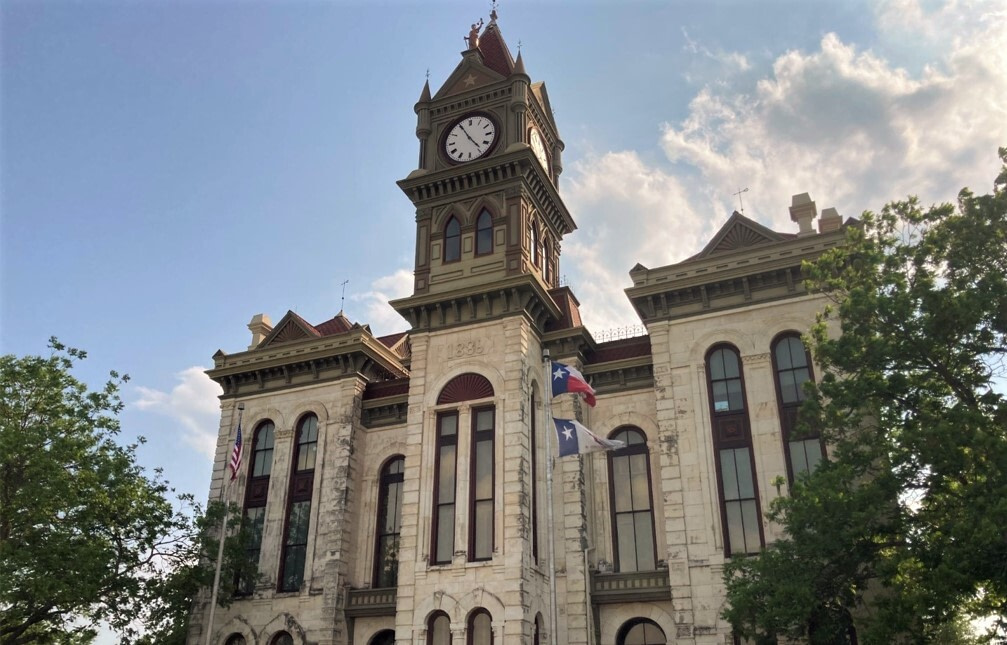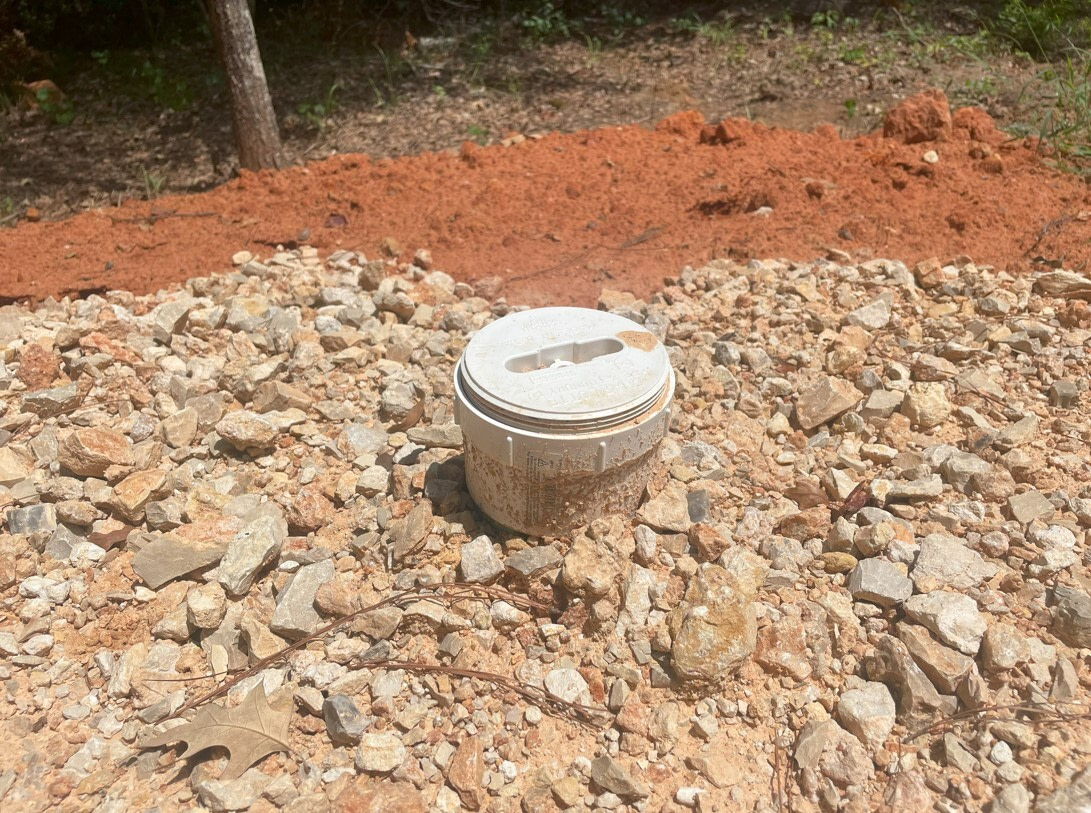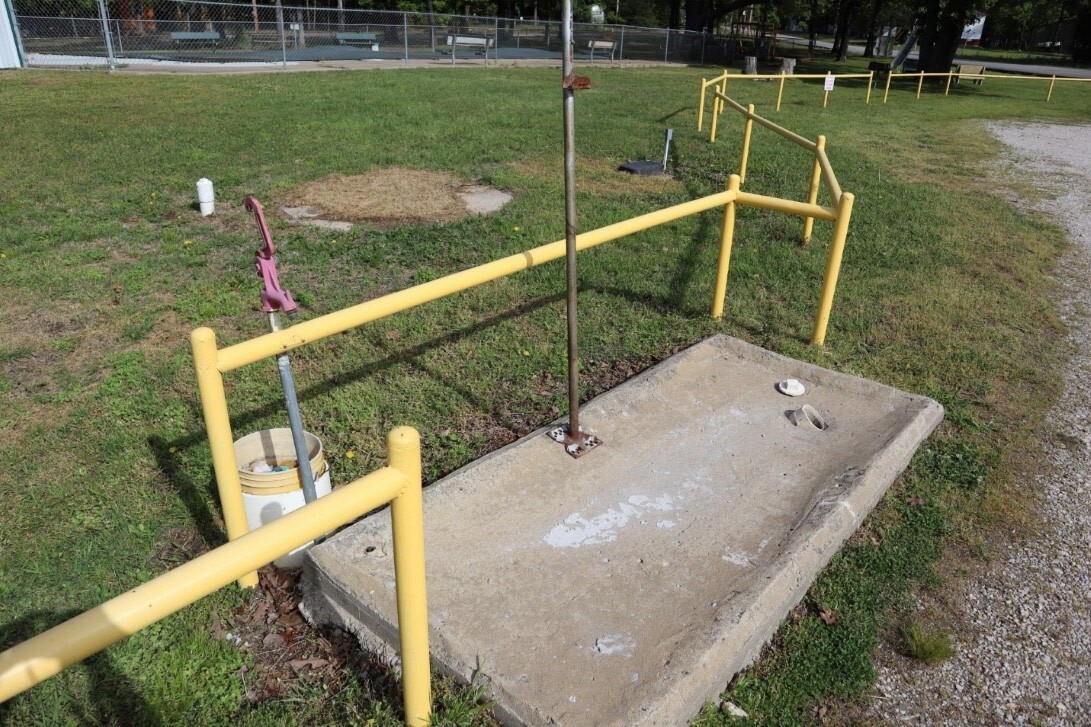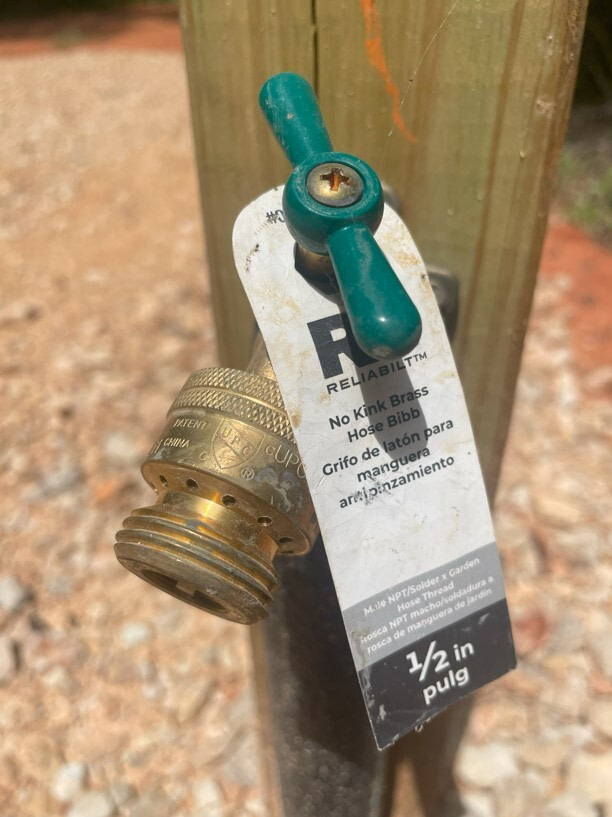Why do we love Texas?
Freedom? Check. No State Income Tax? Check. No Zoning? Check.
What’s not to love about the Lone Star State? As America’s hottest market, it’s a destination rich in limestone cliffsides, scenic river floats, massive state parks, and gulf-coast shorelines. But it’s also become a real estate haven for RV Living and retirement communities for its stability, low crime, ease of restrictions, and protection of private property rights. But make sure your new home is going to check the right boxes.
There’s no zoning in Texas! BUT you better check for code ordinances!
A simple Google search (city name) + “code ordinances” to find it and search for the terms “travel trailer”, “RV” or “self-contained”. Read over the sections that address these topics and see if the city explicitly forbids living in an RV or Travel Trailer and how they define the term. Also be sure to also search (county name) + “Texas code ordinance” to check for any county-level regulations
If nothing in Google turns up, search for a city hall number and call the city hall during business hours.
If there is nothing for either, you are most likely in what is called an “unincorporated area” which basically means your land calls outside of a jurisdiction aside from the county level. These are essentially unrestricted and come with the most freedom.
Is there an “Active” HOA?
Emphasis on the word “Active”. The Texas legislature just passed a series of laws in 2021 under Senate Bill 1588 putting heavy oversight on homeowner associations to prevent fraud and abuse. In order for an HOA to remain in “Active” status, it must maintain the following types of records:
- Must have an active website to post bylaws and meeting minutes
- Must be able to provide you with a statement of your account
- Must have the HOA bylaws and restrictions filed in the county records
- Must provide members with timely notice about meetings
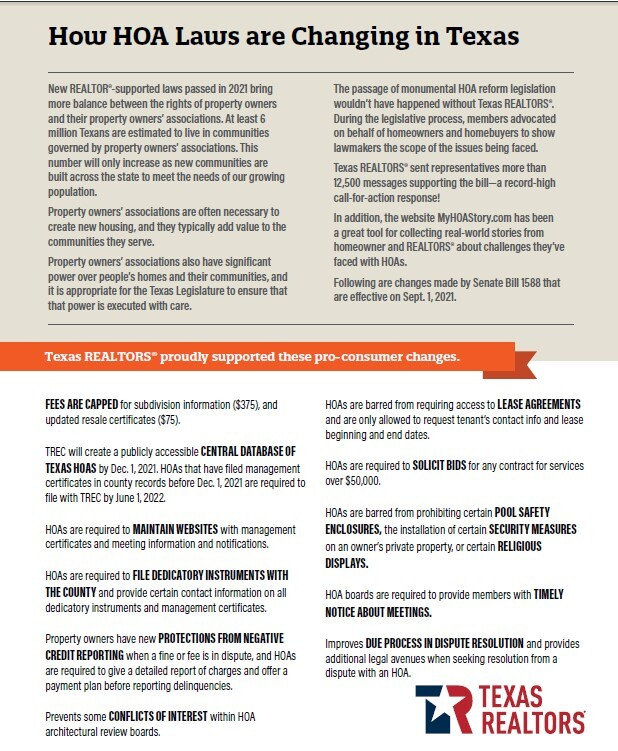
To Find out whether your Home Owner’s Association has lawfully filed its Management Certificate with the Texas Real Estate Commission, you can search for it here: https://www.hoa.texas.gov/
Check for restrictions on RV Living in the HOA By Laws
You can request this copy directly from the HOA or visit with your local County Clerk and ask if there are any deed restrictions on record for the neighborhood you are buying in
What exactly do we consider RV living? To us, it is all about whether you can live in or long-term store your RV on your lot. RVs come in a variety of terms and definitions but essentially, we are talking about travel trailers, campers, motor homes, trailers, and 5th wheels that are either totally self-contained or have a hookup solution to dispose of waste.
The ideal situation you want is one where you don’t have to move your RV or trailer more often than once a month. The major reason for this kind of requirement is to make sure neighbors don’t let their RVs become abandoned on the lots or unable to move them in an emergency.
Check for the Lot Dimensions
If you have a survey – that’s great. If not, you’ll need one before you start developing. But it’s not necessarily critical at the purchase stage unless you’re worried about access. If it is in an HOA, City, or subdivision development, it was surveyed at one point in time and the surveyors put iron pins in the ground. When you hire your surveyor, they can relocate and flag those pins for you.
If you want to save money, you can try asking your surveyor to perform a “boundary survey” where they come out and mark the boundaries without charging you to re-create a plat. Not all surveyors offer this and many require that you purchase both when working with them, but its worth asking to find out. Don’t forget – you can always bring out your own metal detector to locate those pins. Just expect to find a bunch of beer cans underground while you’re looking for those corner pins.
What is important though, is making sure you know the dimensions upfront and will have enough room to haul in your trailer, have enough swing room to get it off the road and onto your lot, and once your rig is parked and settled, making sure you will be left with enough space to install a septic system when all is said and done.
Gather the County Parcel ID
Gather the County Parcel ID from your seller and then Google Search (county name) + “Texas Property Search” to find the county’s central appraisal district records. There, you will often find a prompt asking for the property owner’s name or that Parcel ID #. Perform a search and most counties these days will feature an online GIS map that will pull up the lot right on your computer and provide measuring tools (in feet) to draw around the lot’s boundaries and get an approximation for the lot’s dimensions.
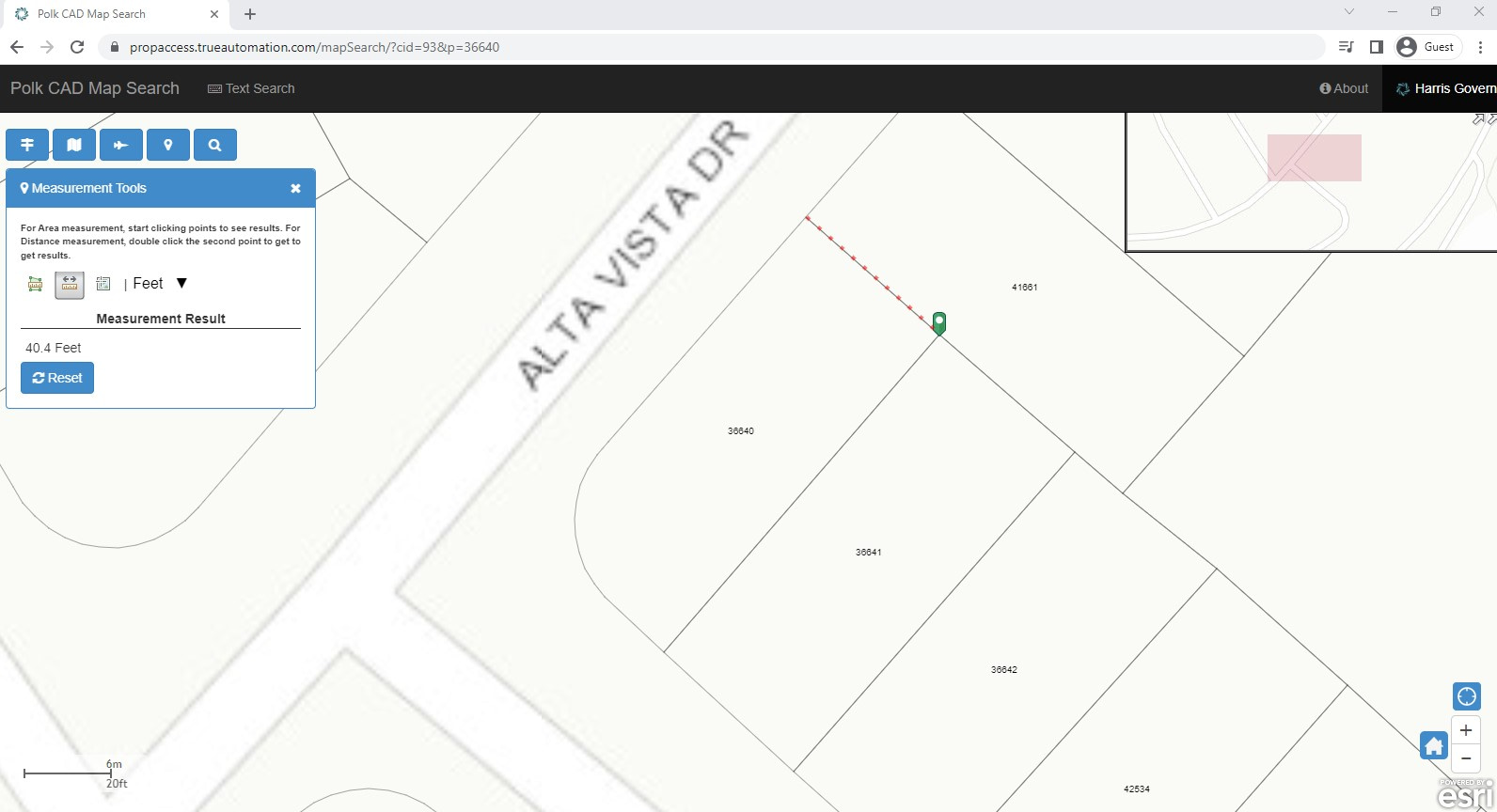 Note: In this County’s CAD Map, You can select an area to draw and measure the acreage in a polygon or draw straight lines along the borders and get a running measurement result on the feet.
Note: In this County’s CAD Map, You can select an area to draw and measure the acreage in a polygon or draw straight lines along the borders and get a running measurement result on the feet.Visit the County Clerk’s office
These are available for walk-ins to the public, and if your lot was surveyed at any point in time, there should be a public record of the overall neighborhood’s lots surveyed one by one. This is called the “Plat”. The County clerks can be very helpful and if you tell them the name of the neighborhood you are looking for, they can direct you to the Page # and Cabinet # that the plat is kept in and they usually provide a copy machine to make copies for free or a small fee.
In our experience, as long as you have at least 20’ of road frontage and at least 70’ of depth, you will be able to establish a driveway, with a culvert (if you need one for drainage), and be able to get your rig (or a full-size mobile home) into the lot should you decide to do something different.
Is there a solution for Sewer?
Obviously, Power and Water are important, right? Almost all of the properties we feature on Elegment Land’s RV page in Texas have access to power and water. But it is much more uncommon to find land that features BOTH access to sewer and allowance for living in your RV full-time. Generally speaking, you’ve got 4 choices for Sewer.
Municipal or “City” Sewer
You lucky dog. If there is a sewer line that runs in front of your lot, you can consider about $7,500 – $13,000 (depending on the area) in money saved by not having to install a septic system.
Conventional Septic System
This is one of two types of OSSF (On-Site Sewage Facility) that we discuss here that feature your typical concrete tank that gets installed in the ground and gets serviced when it’s time to empty it. These should be installed at least 50’ away from a water source and the lines should not cross for contamination reasons. Typically, these do not require a power source and a great for larger acreage or areas where the soil is permeable.
Aerobic Septic System
This is the 2nd type of OSSF and is better suited for either ground conditions that cannot support a traditional leech field, smaller lot sizes, or rocky conditions. These types of systems act as miniature sewage plants and do require a power source to run periodically. These are the more expensive type of systems than conventional, usually running approximately $3,000 – $5,000 more than a conventional system. A great resource on the topic of septic systems if the EPA website itself: https://www.epa.gov/septic/types-septic-systems
Public or Private Dump Stations
If you are on a budget, this is going to be a great solution. Many neighborhoods provide these to property owners at the community building or many nearby parks and campgrounds also often offer these for a fee. A great resource to help you locate public or private dump stations nearby your lot or on the go is the All Stays “RV Dumps” app using iPhone or Android. This app comes with a map feature that you can pan around and find disposal sites nearby.
Is my Property in a Flood Zone or Wetland?
While this one is obvious to check, it is not always intuitive to find out. Most counties are “flood zone mapped” which means FEMA has mapped this area and determined which areas are within the “100-year floodplain”. Some, however are not (such as Falls County) and a survey does not identify floodplains or wetlands.

Check out our guide on How to Search Floodmaps for Free Online where we walk you through how to drill down into the location of your property.
Remember that flood zones or wetlands are not always “deal killers”. Beach community properties for example are obviously flood zoned but that’s expected. Having a running creek or even a seasonal creek running through your property enhances the value and increase the amount of wildlife you’ll be able to attract.
Even being closer to the water table means easier depths to drill a well.
At the end of the day, you really just need a 10’ x 30’ elevated space that can be supported with road base in order to stabilize your trailer.
Now You’ve Found your Dream Property. What should you do first after Closing?
Get a 911 Address: We always recommend this as Step # 1 after closing. Most raw land properties do not have addresses established yet unless there was a residence there in the past. The reason you want a 911 address even before you do any work on the property, is because it allows emergency and utility providers easy identification of the property.
Once you have it, it becomes usually becomes just a matter of weeks until your new address becomes searchable in google maps.
To find your County’s 911 Addressing Department, you can usually Google Search “County”+”State”+”911 addressing” and you’ll be guided to the right place. You can also get a referral from the County Clerk and request the “Office of Emergency Management”.
There is usually a small fee, $25 & up depending on your county.
Depending on your County, you may be asked to set a stake on the ground at the road frontage of your property where your future driveway is going to go. This doesn’t necessarily need to be the center-line of where it is ultimately going, but it does help the County with their mapping, which will direct future traffic (emergency, utility providers, deliveries, etc.)
I’m Ready to Start Working and Digging
Get a Survey
As mentioned earlier, at the very least have your boundary corners survey staked or located by a professional. We recommend trying to purchase this and get on your local surveyor’s schedule months in advance of any work you plan to do. Surveyors are in heavy demand these days and you must accept that they will get it done when they can get it done. Preplanning is everything. The last thing you want is to start clearing your neighbor’s property by mistake.
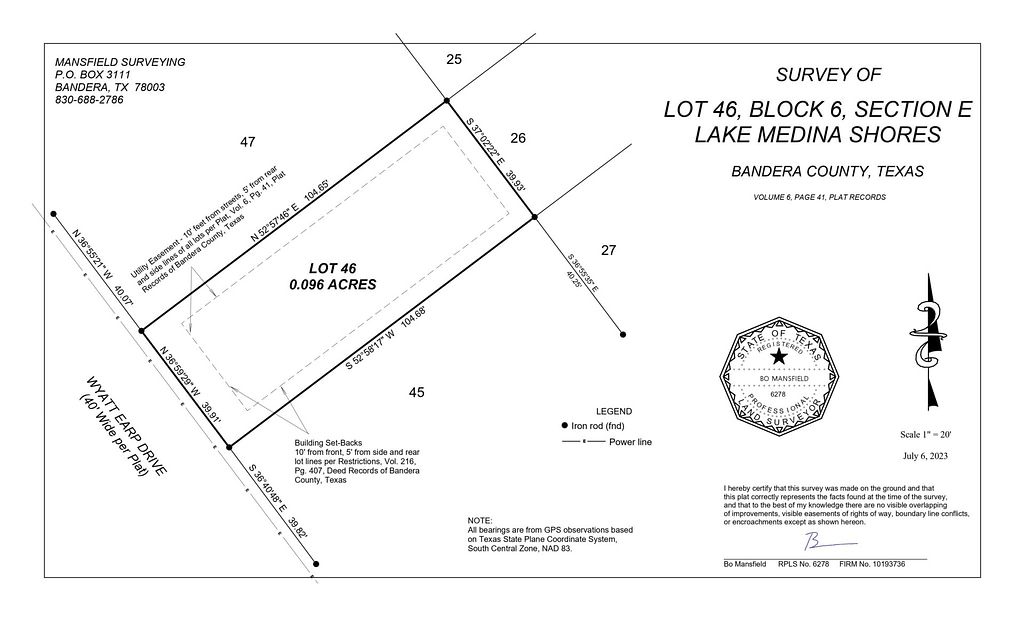
If you paid for a plat, study your survey and observe any easements that run over your property. If you have road frontage, the County or State and Utility Companies will often have lines running across your property. You will want to avoid hitting those and make sure your contractors are aware of them. A good contractor will call 811 to locate the lines before they start work.
Call 811
Call 811 early on If you are doing the work yourself and request a location of all utility lines. The dispatch will find the providers in your area, notify them of your request, and they will usually come out over the course of 2 – 3 weeks to mark your property. Similar to your 911 address, a ground stake by the road is helpful for the utility providers to find your land if you don’t already have an established 911 address.
Check for Setback Lines
If you are in an HOA or deed restricted community, these can be found in your community guidelines. These will describe the amount of feet you need to be away from a boundary line before you can set a permanent structure.
Development Permit
Check if your County requires one. These are usually roughly $100+ (again, depending on your County) and these are usually required before you start work on your property. This isn’t for activities like brush management, temporary structures and things like that. But once you start interrupting the flow of water (such as setting a culvert at a drainage ditch or setting a driveway from the road), or start laying the groundwork for a permanent structure, it is common that you will need to get this permit before you start work.
Culvert Permit
A Culvert Permit is inexpensive, usually $25+. Your county may require this in addition to the Development Permit, or maybe not at all. Or combined into the same permit. Local guidelines apply, just keep in mind that your county very likely is going to have someone that will have a standard on the size of the culvert that will be used for your driveway and perhaps also the type of material allowed. Depending on the size of the ditch, the most common sizes are 12” and 15” culverts. But this can certainly go up if there is a lot of water flow. Materials used are usually plastic or galvanized steel.
County Commissioner
Consider finding them and ask him or her to do a ride along with you to the property. They serve the community just like any other public official and they have a wealth of knowledge about the area and can help you evaluate the drainage on the land, showing how water drains off the property. Of course, many commissioners are very busy and their availability all depends on your area, but in larger communities, there may also be Road and Bridge departments that serve the same purpose or they can refer you to someone at the county level that can help.
Setting up your Utilities
This all depends on your timeline. If you are primarily looking for a camping ground or storage solution for your RV, then utility installations may be less critical to do now. But if your goal is to start living off the land, you’ll want to start working with your utility providers as soon as you’ve closed and you have your 911 address ready.
As a general rule of thumb: If you have access to any public or community utility running through or in front of your property (Power, Water, Sewer, Gas, Cable/Internet, etc.) we recommend that you at least establish meters at the road for those services as soon as possible regardless of when you plan to complete your buildout. There are a few good reasons for this:
Reason # 1
They can be a limited resource, especially Water. If you are in a rural area and a water line runs by your property, you are in luck. A great question to ask your Water Utility District is what diameter pipe runs through your property.
- A 2” pipe is usually capable of serving only 10 homes in the area. It varies depending on the pressure conditions and distance from the nearest pump station.
- A 4” pipe can serve 1,000 homes in the area. A minor difference like that in the diameter can make a big difference in the pressure and water availability.
- Regardless of the size, if your district confirms you can tap in, it will commit the water district to have to provide you with service basically forever. Water meters do not get ripped out of the ground after they go in. In this case, the early bird gets the worm, and if you are rural enough to be serviced by something as small as a 2” line (which is very common!) it is extremely important that you get in line to fill one of those 10+(-) spots ASAP before future applicants are asked to help pay for line upgrades.
Reason # 2
The tap fees are generally only going to increase with time and inflation. They never go down.
Reason # 3
If you look at any blue-collar service around the country you will notice one thing: there are less and less of those people available to perform services. We see many towns, counties and communities where there is only 1 or 2 guys that service a multitude of counties and the schedules to get work done vary. This is an extreme case, but especially true when you start getting beyond 2.5 hours of a major metropolis. Those specialists are aging and (in many places) only a year or two away from retirement.
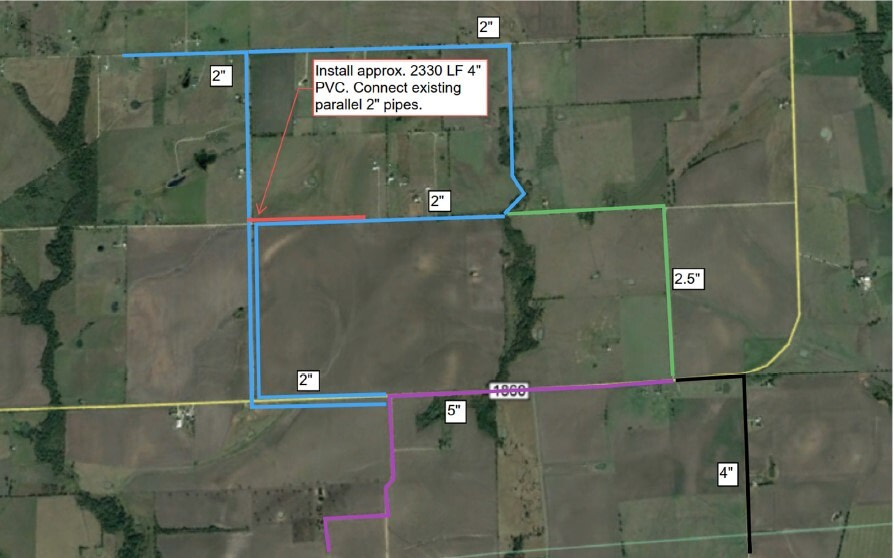
With all of that said, take the time to carefully plan where you plan to work. Such as installing any permanent structures, pouring concrete slabs, before running line extensions from the road. Many utility companies require a 3rd party inspection when you are connecting to the main. Inspectors generally like to see a spring check valve and vacuum breaker to prevent backflow into the water system.
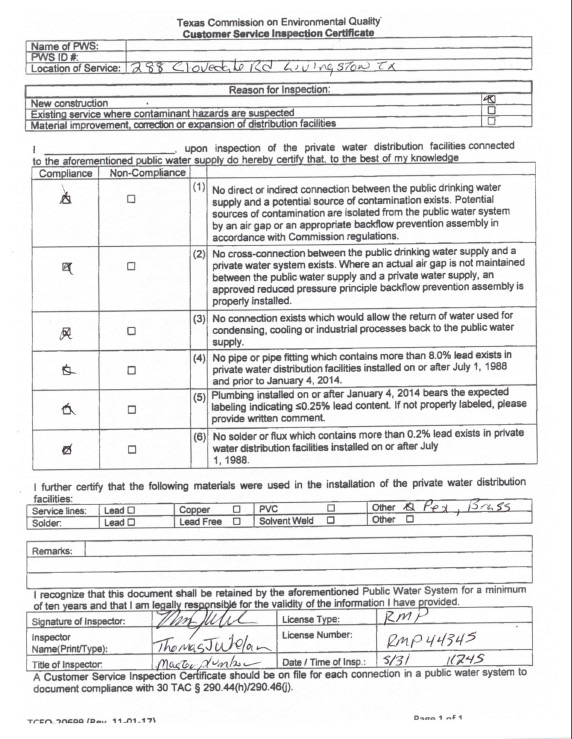
Note: Sample of Form TCEQ-20699 Inspection Permit certifying protection against contaminates back to the main line and the types of materials used for tap installation.
TCEQ Requirement
In Texas, minimum distance for water lines and sewer lines distance can vary depending on local regulations. Generally, the goal is to maintain a safe separation to prevent cross-contamination and ensure the integrity of the water supply. The minimum distance between water lines and sewer lines is typically determined by pipe material, installation depth, and local guidelines. It’s important to consult with local authorities and TCEQ (Texas Commission on Environmental Quality) on these requirements. They can provide you with the specific regulations applicable to your local standards.
Conclusion
In conclusion, Texas offers a wealth of opportunities for RV enthusiasts and those seeking a serene retirement lifestyle. The lack of zoning restrictions, low crime rates, property rights makes Texas a haven for RV living. Checking code ordinances, reviewing HOA regulations, assessing lot dimensions, sewer options, and flood zone status are important due diligence. Individuals can make informed decisions and find their ideal RV destination.
Remember to plan ahead, coordinate with utility providers, and establish your 911 address promptly. You’ll be well on your way to enjoying the freedom and beauty that Texas has to offer for RV living.
Also don’t forget to check our Texas RV Lots Listings!

